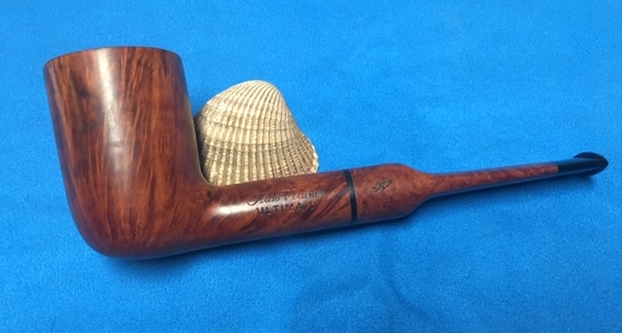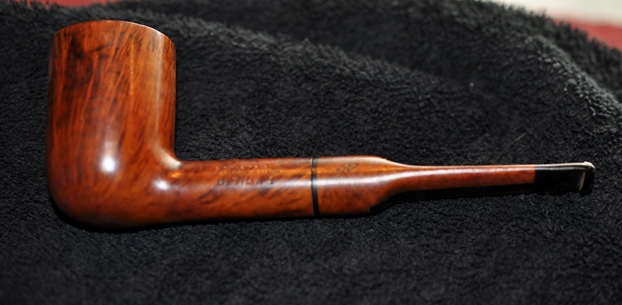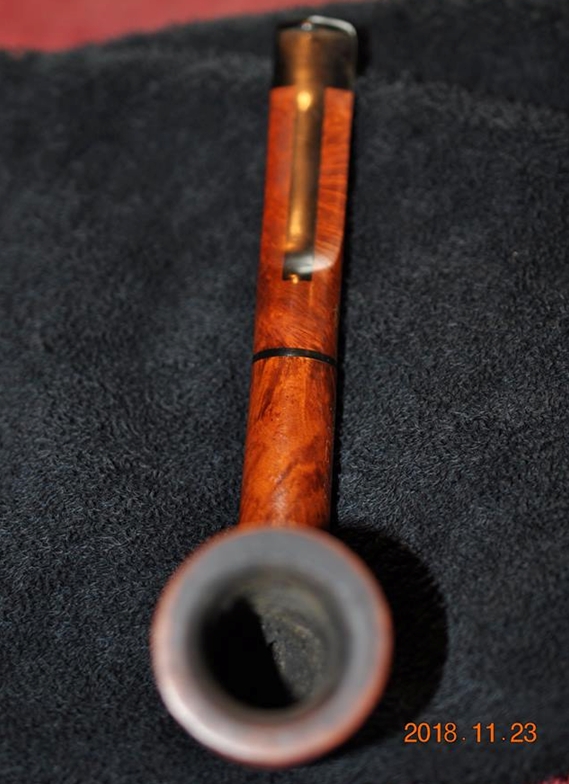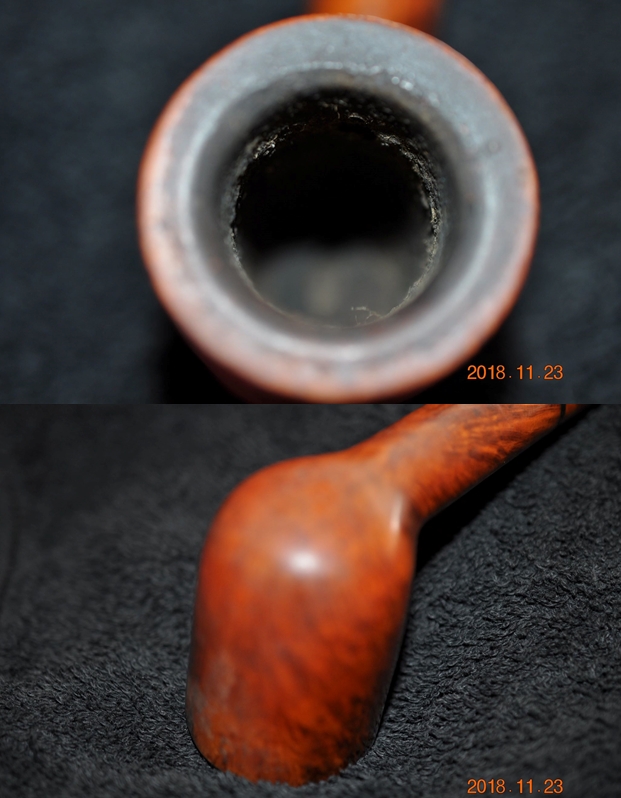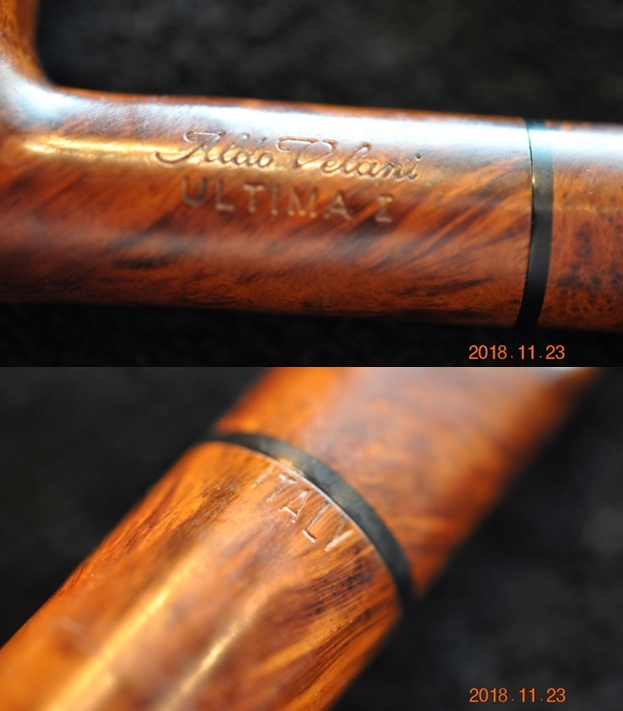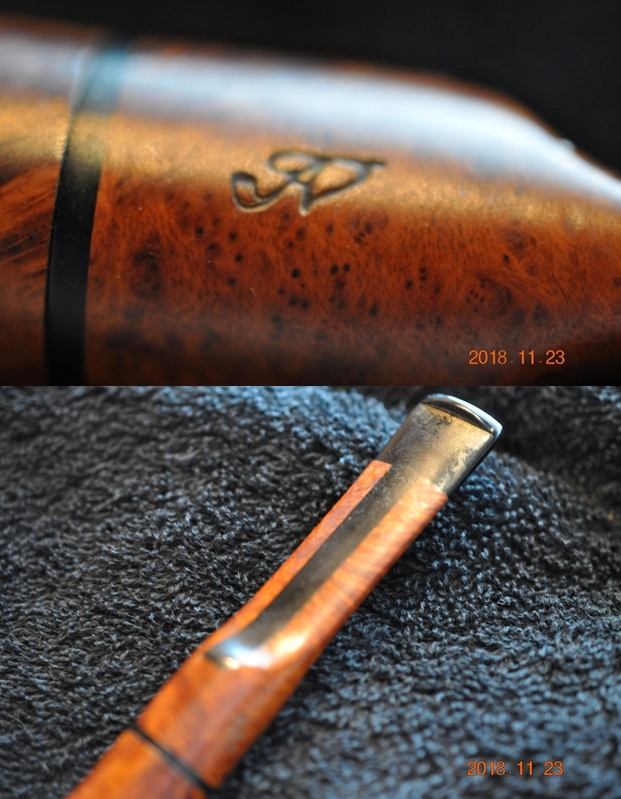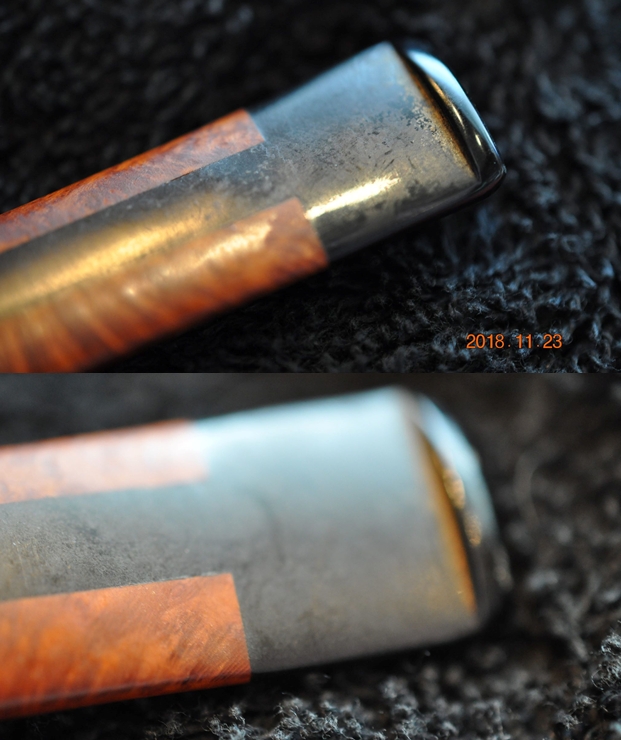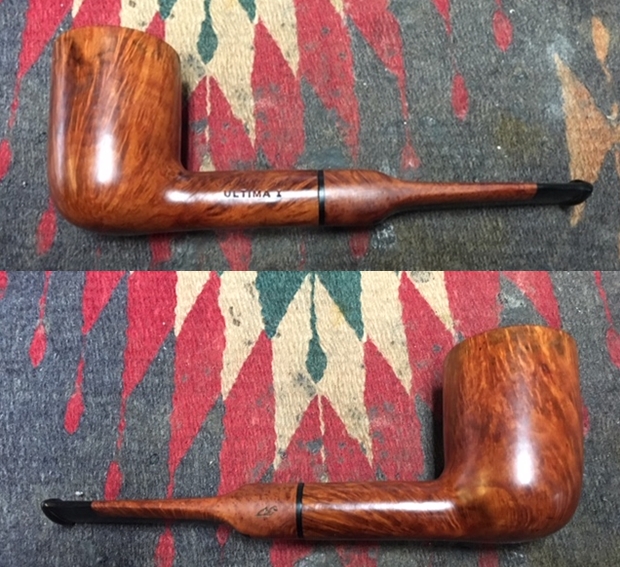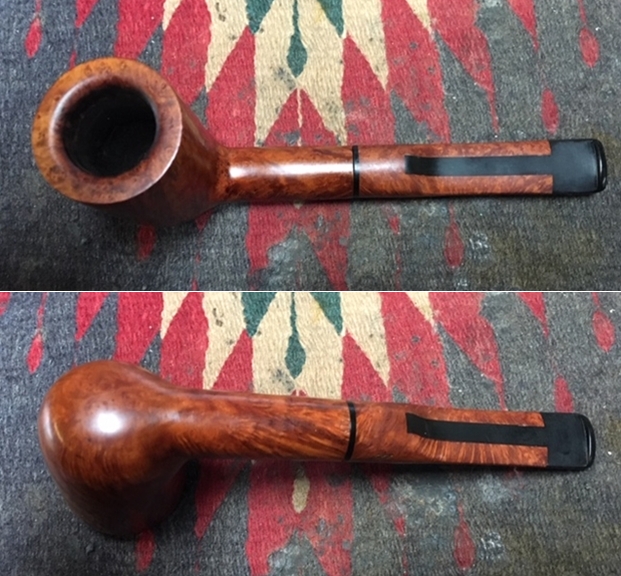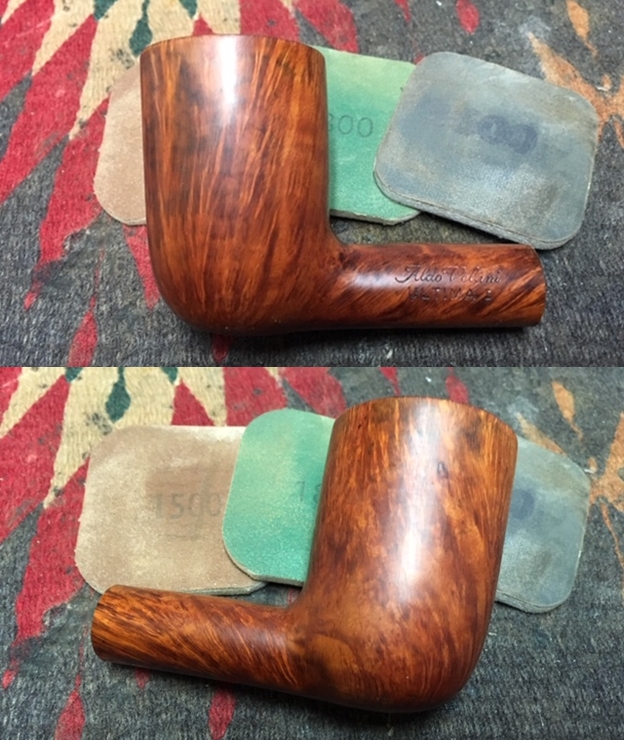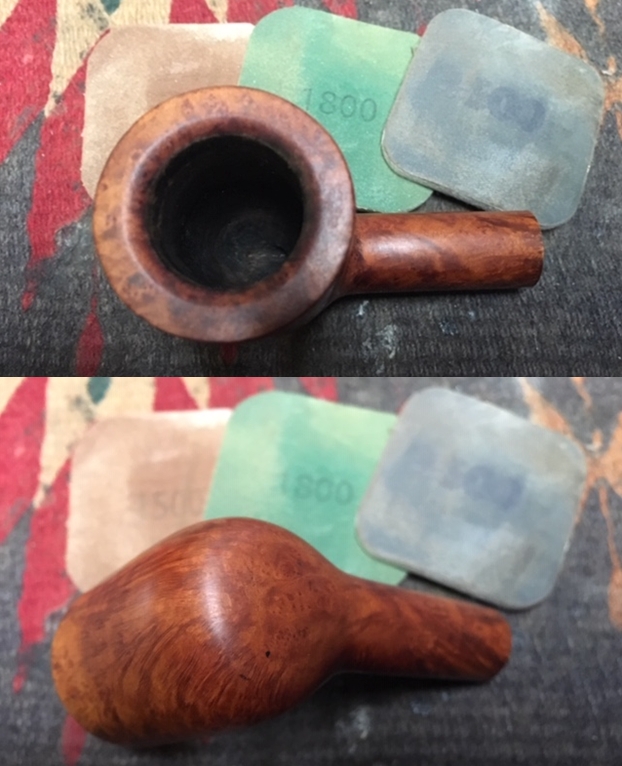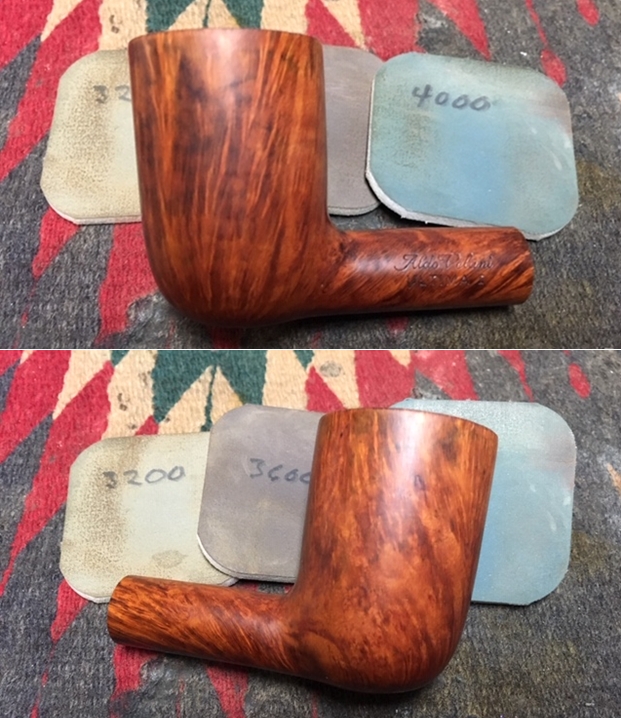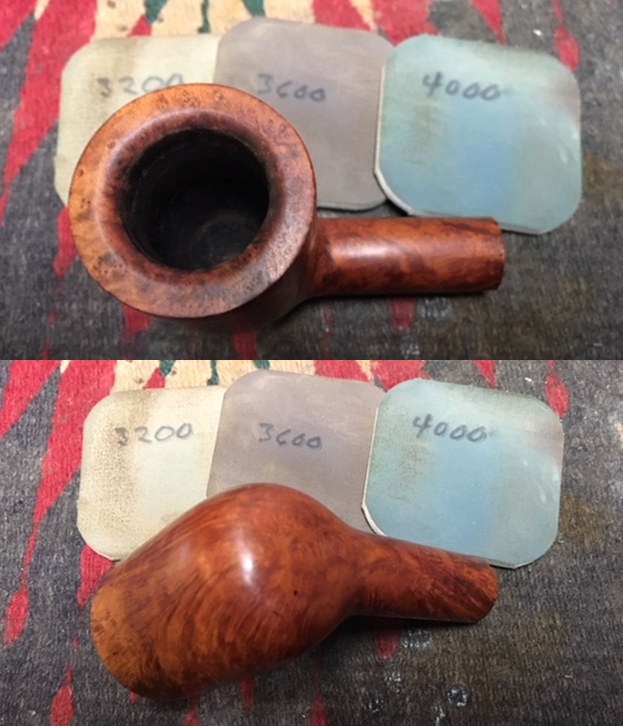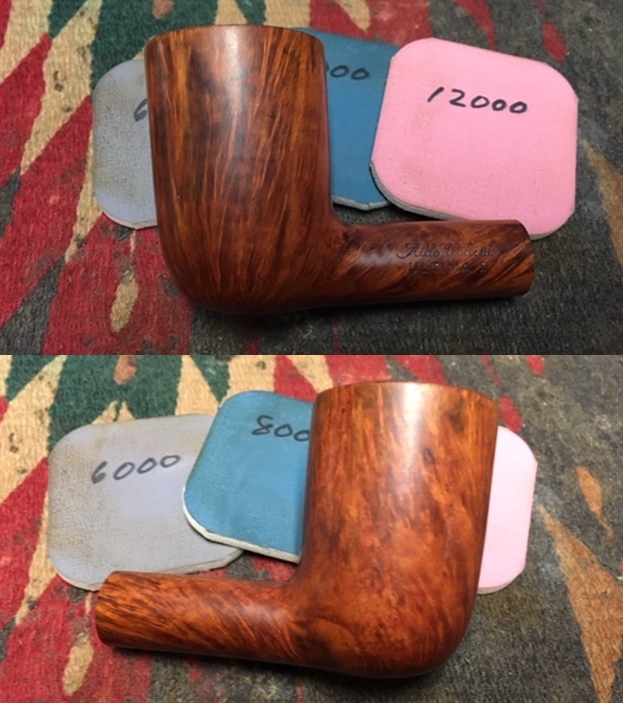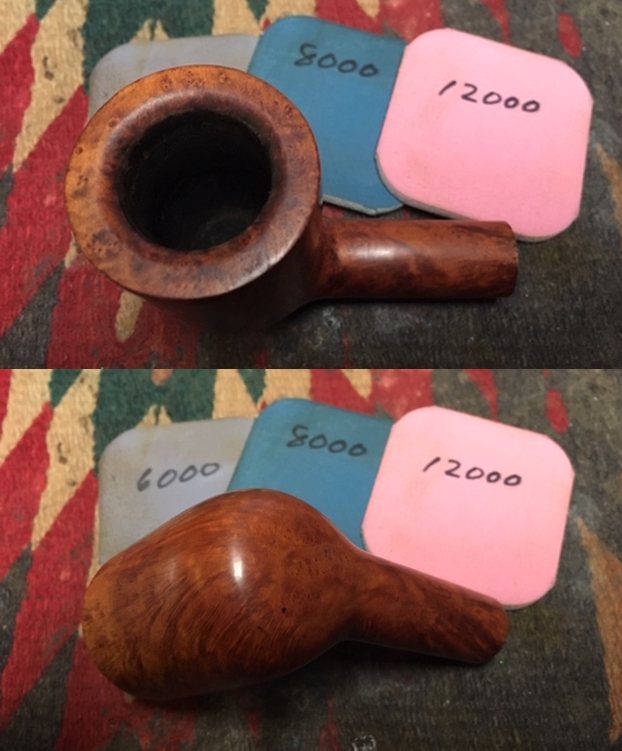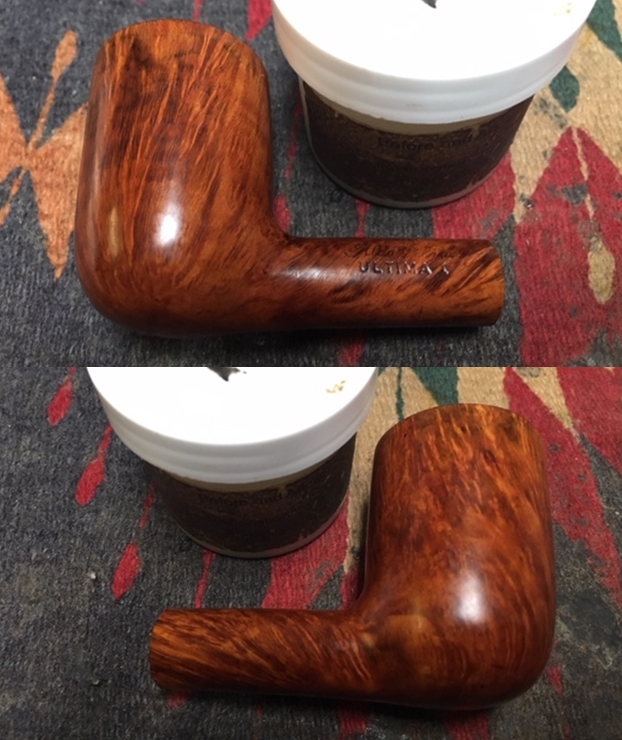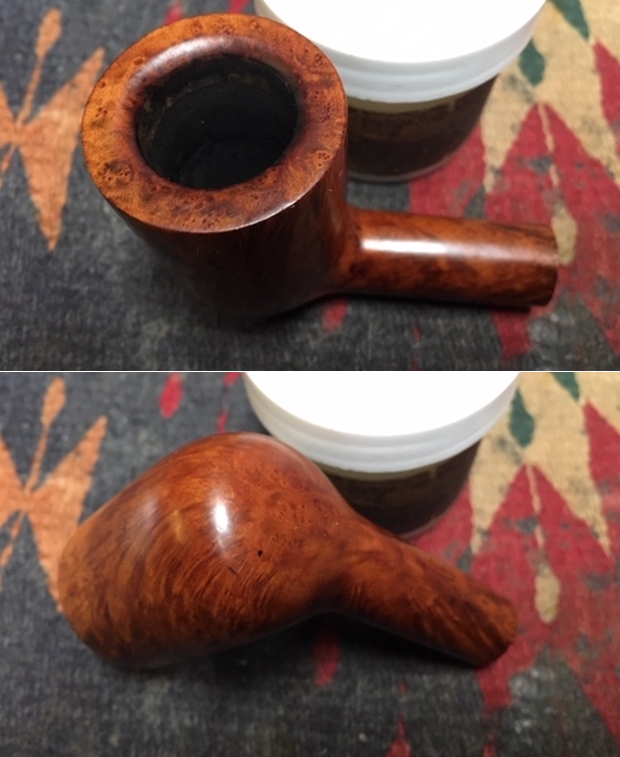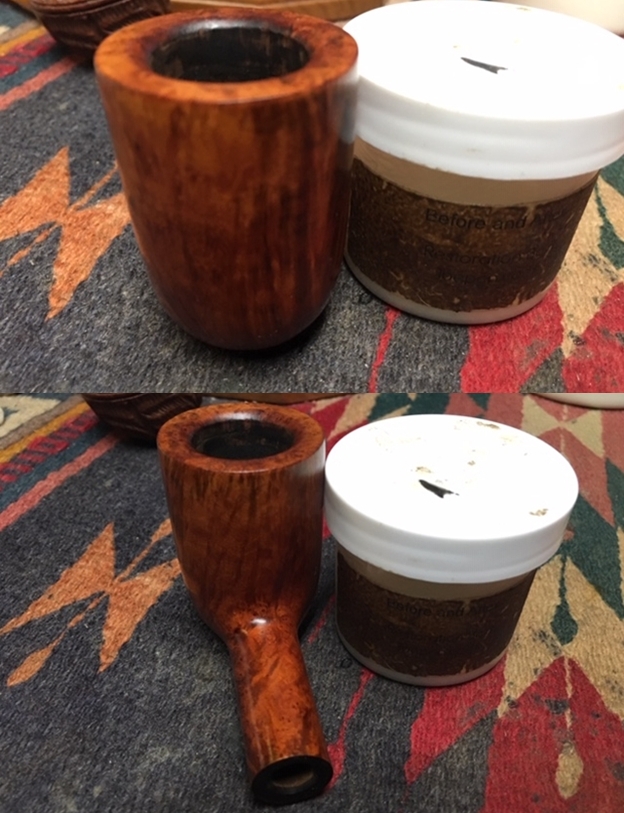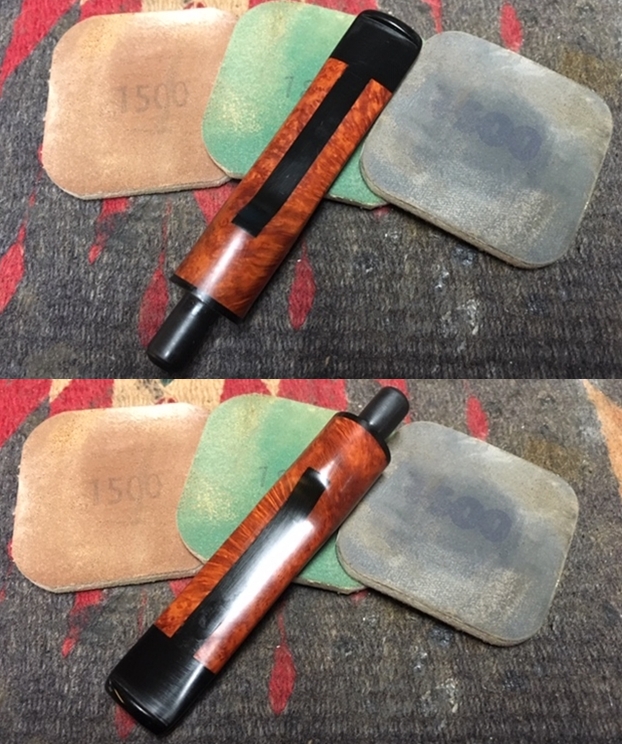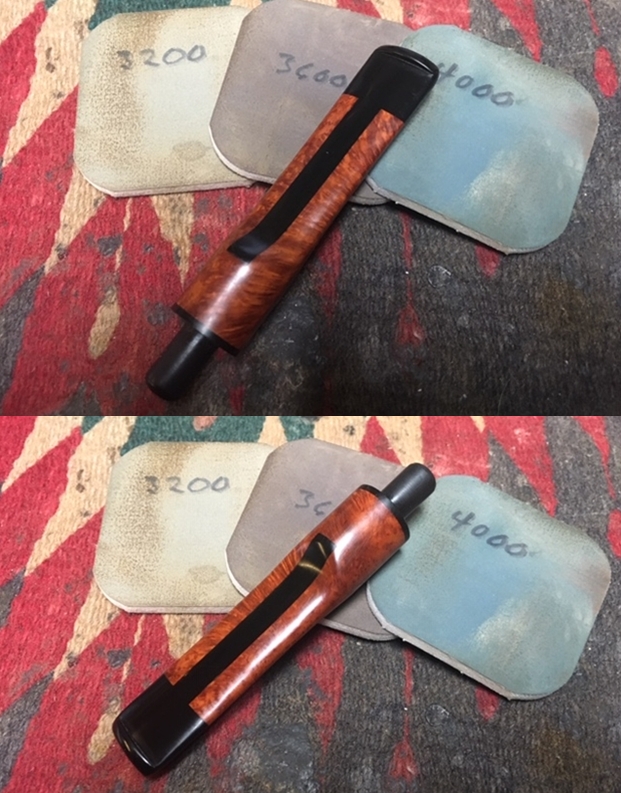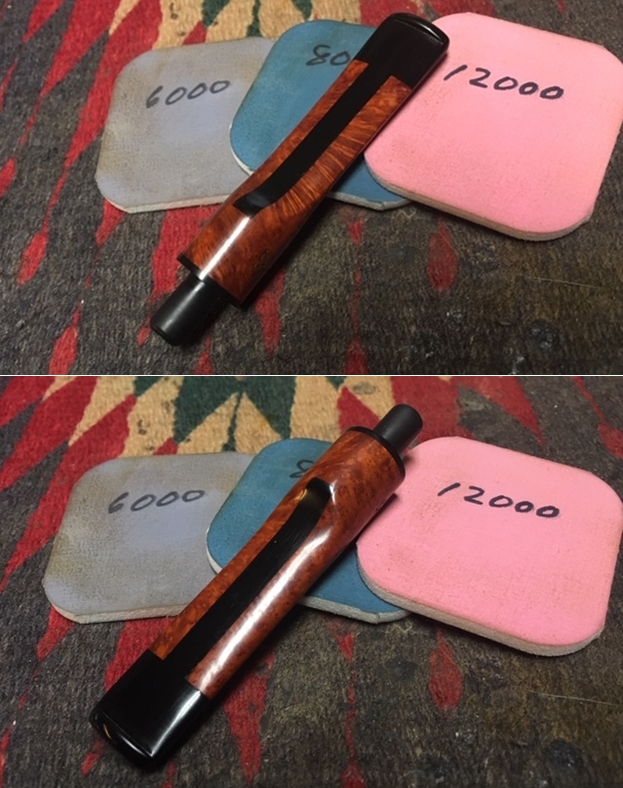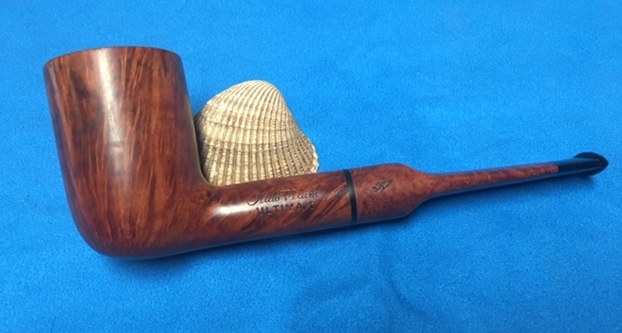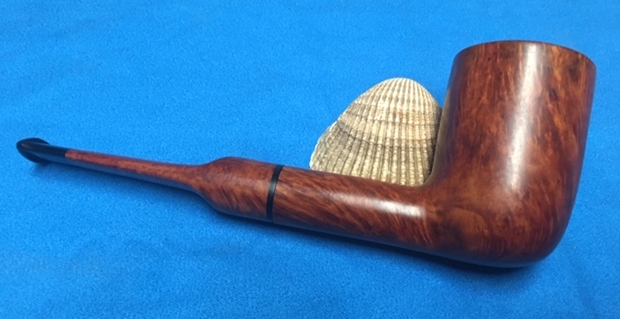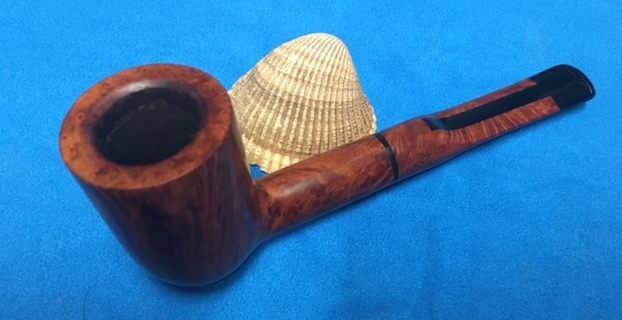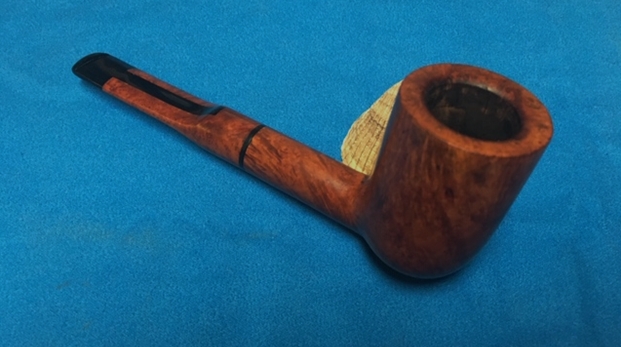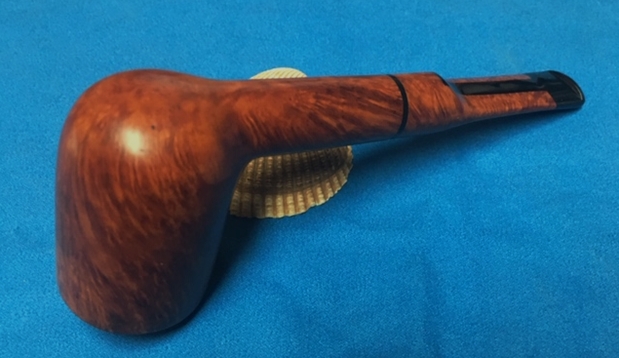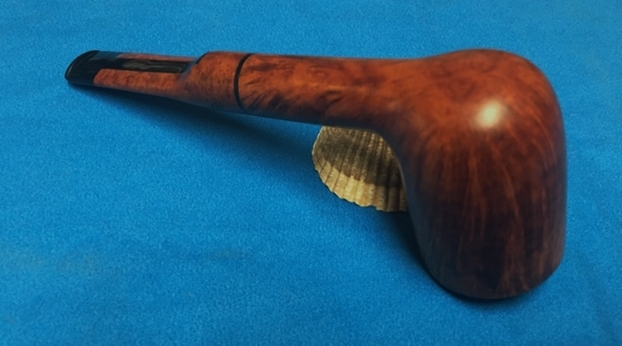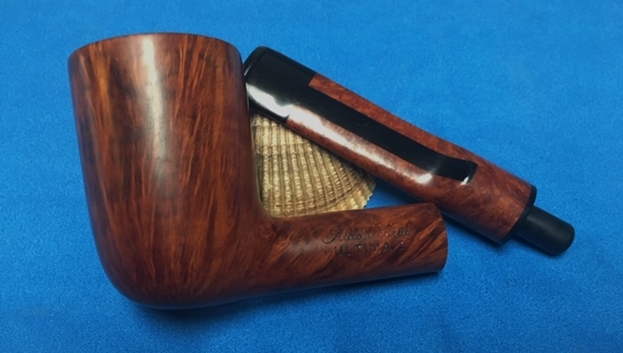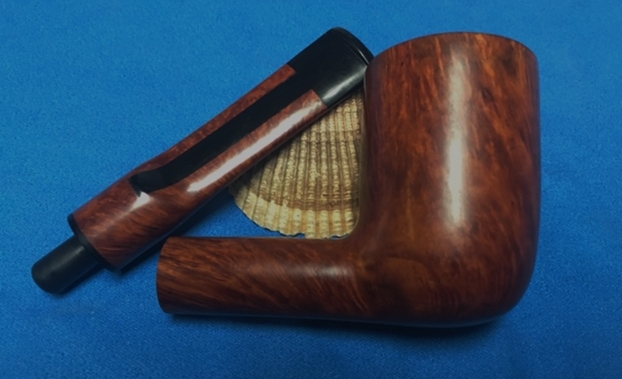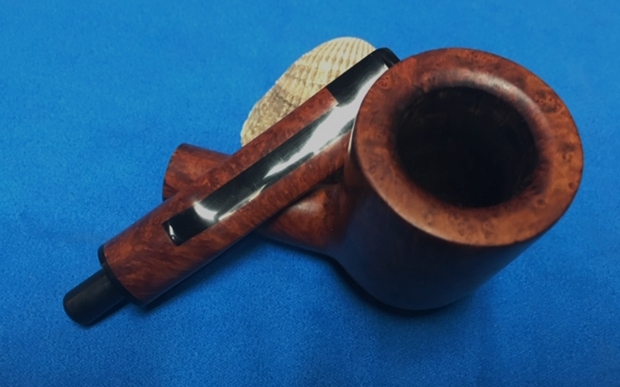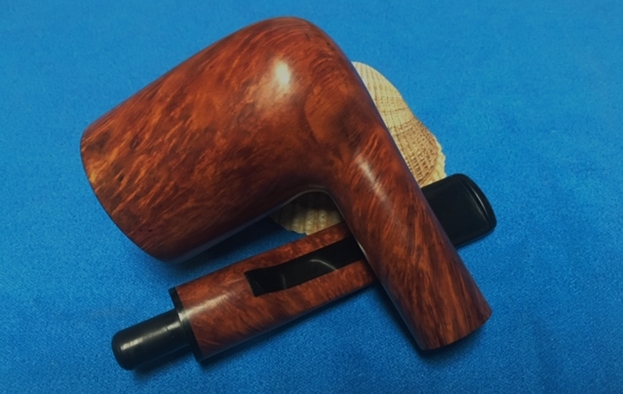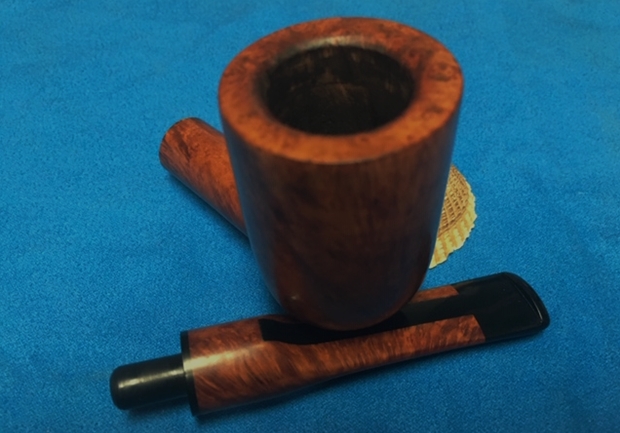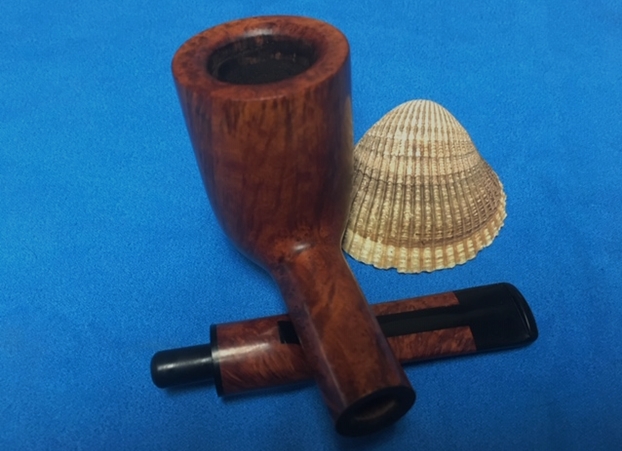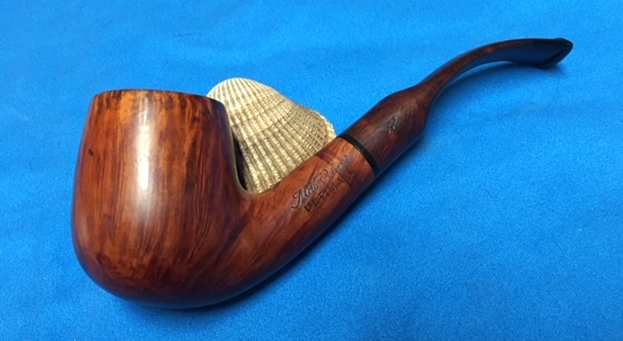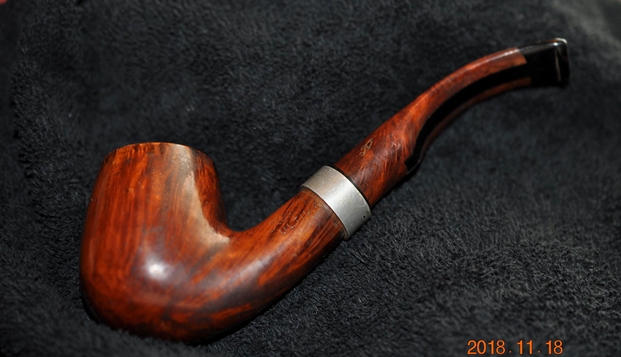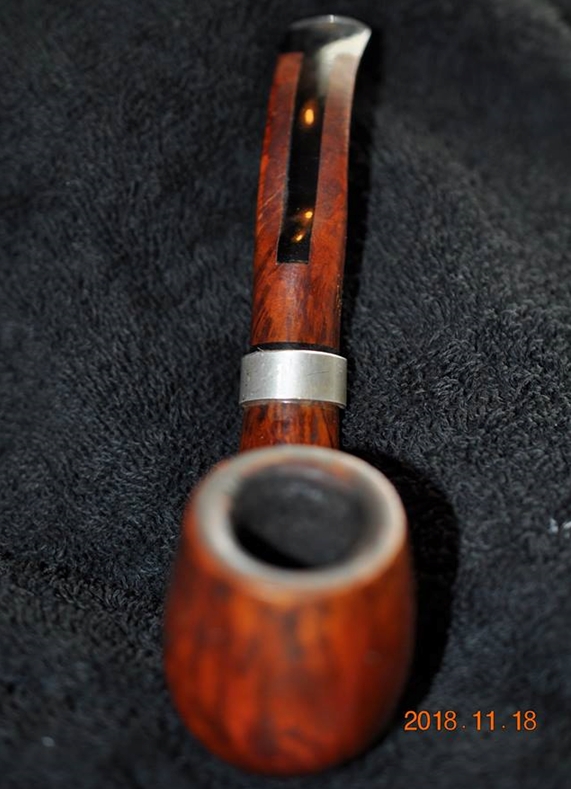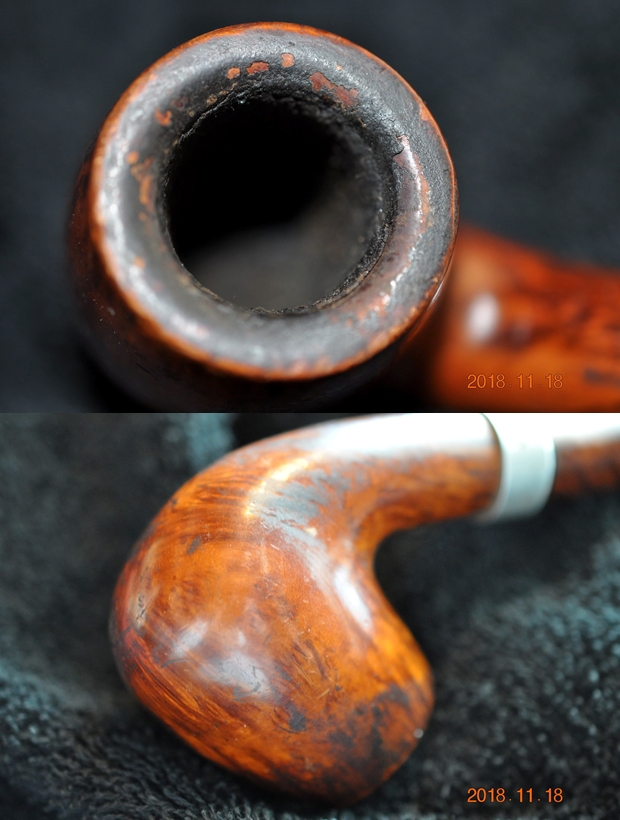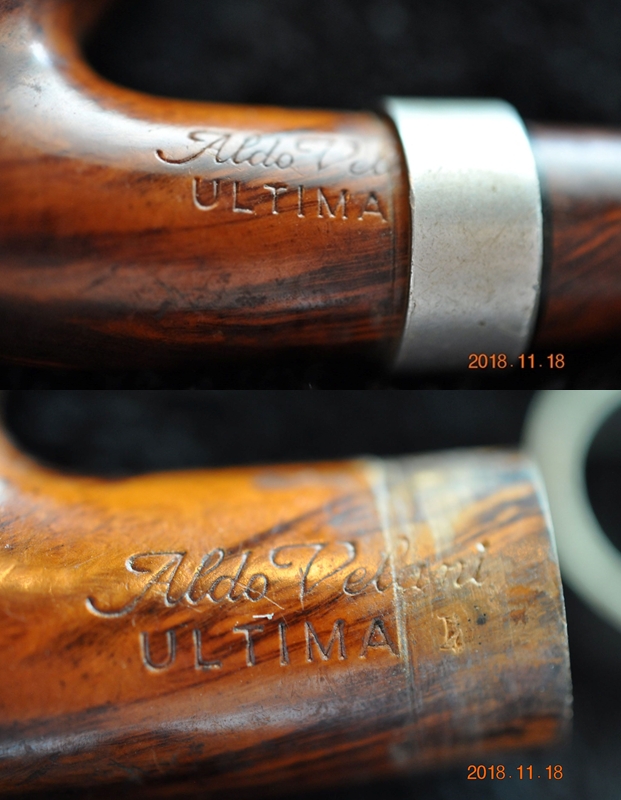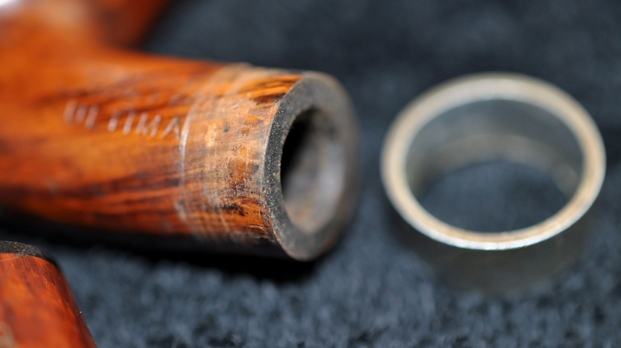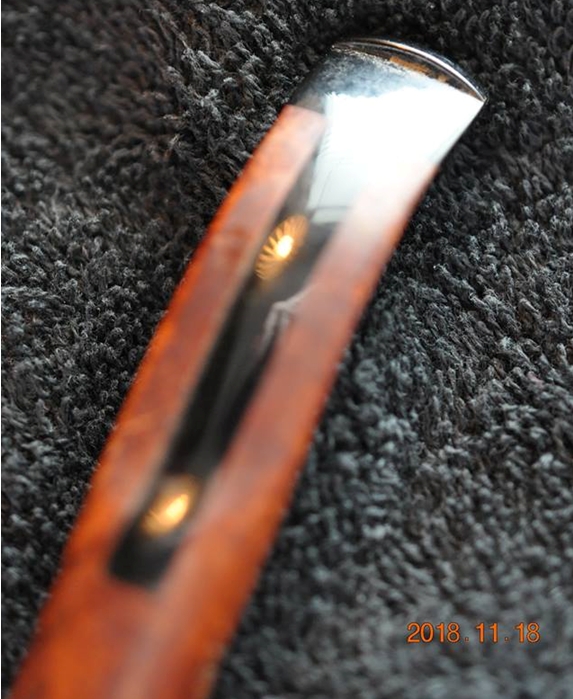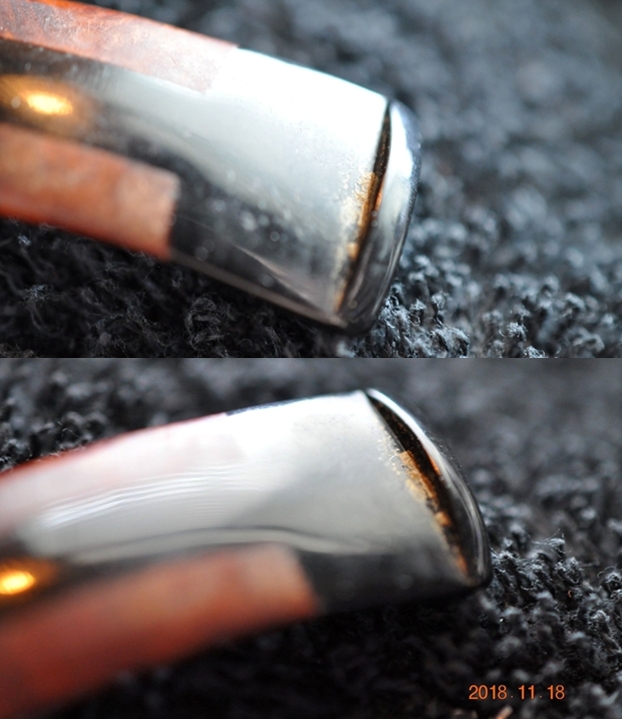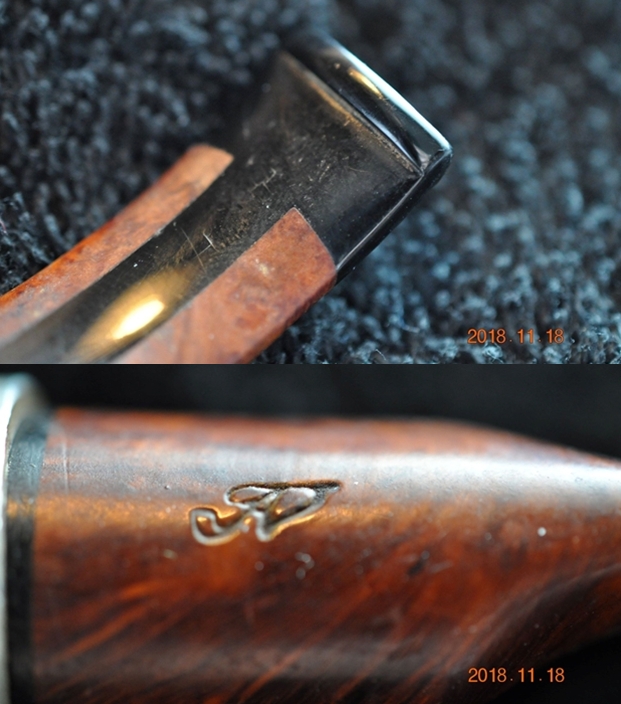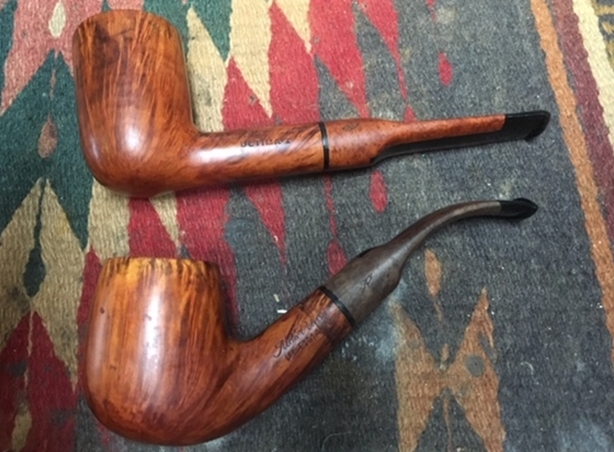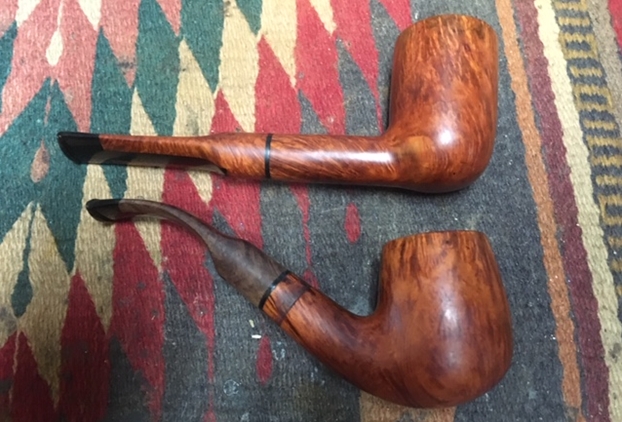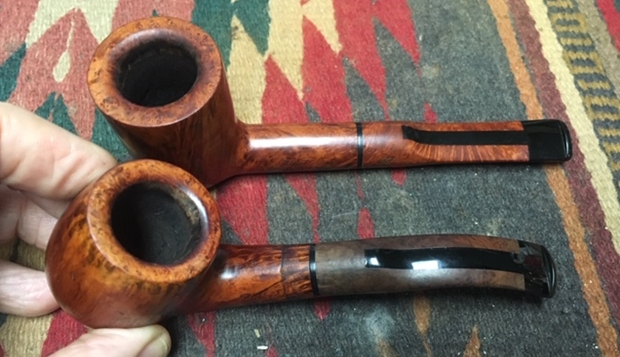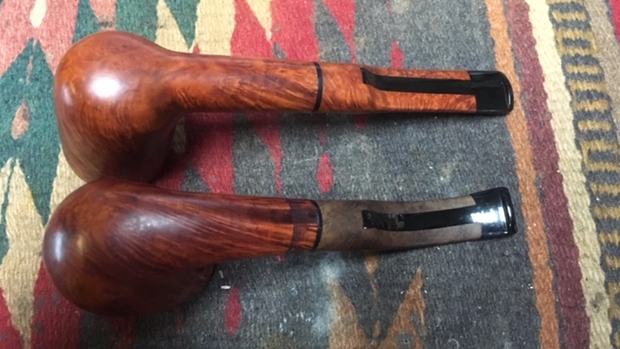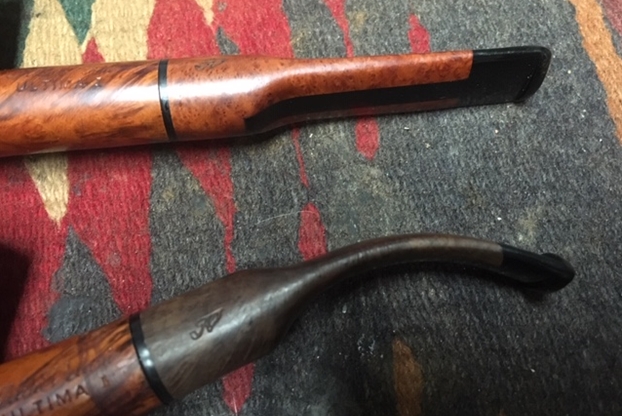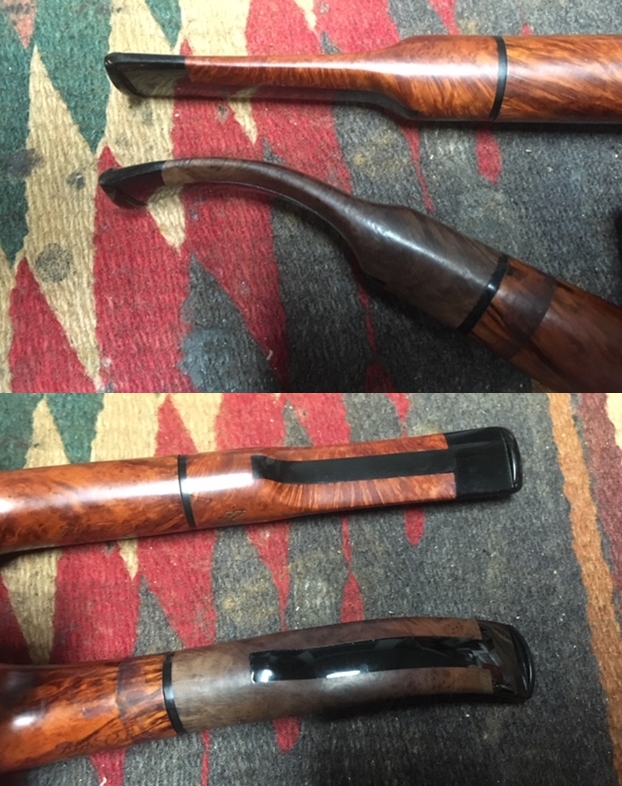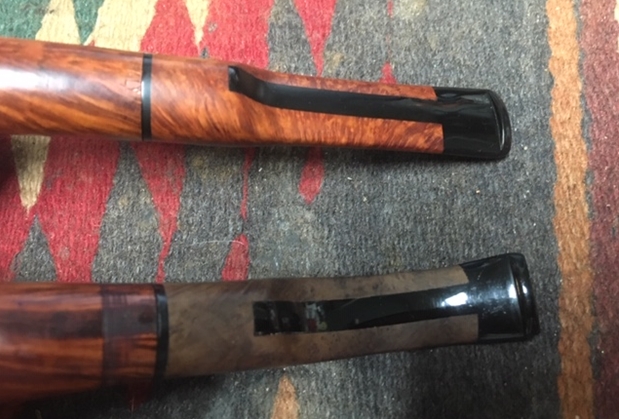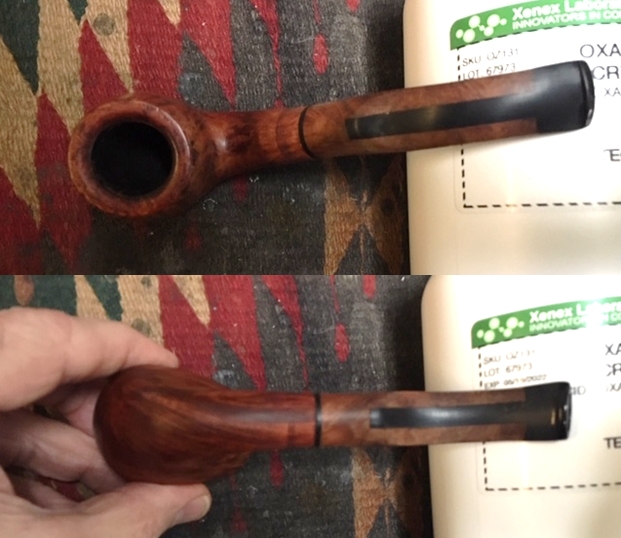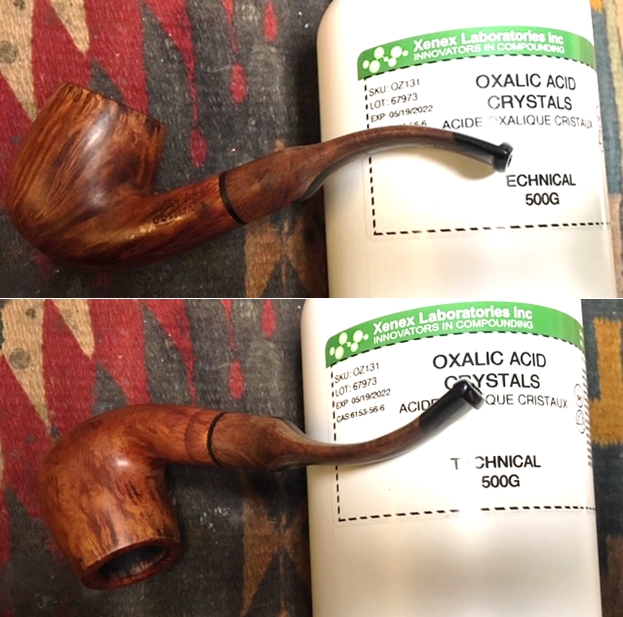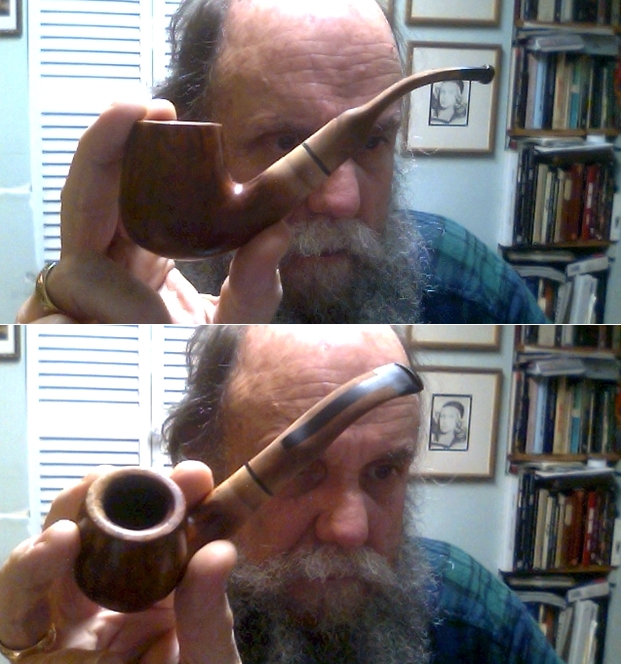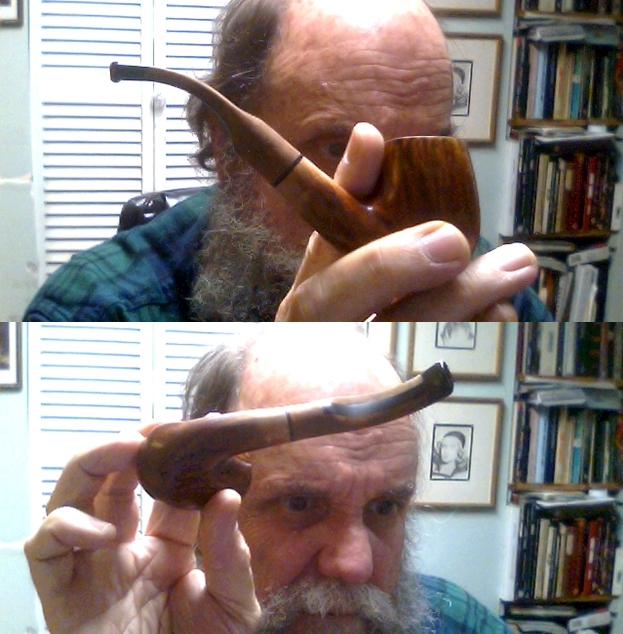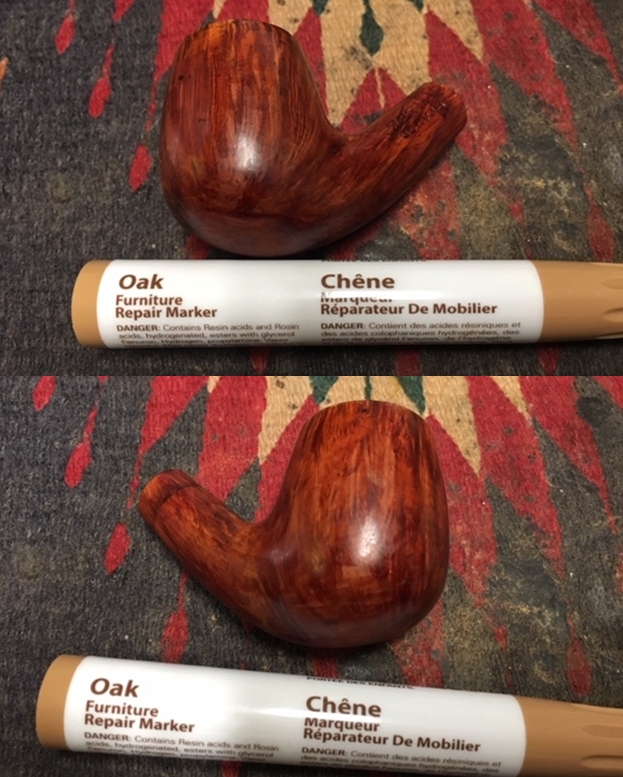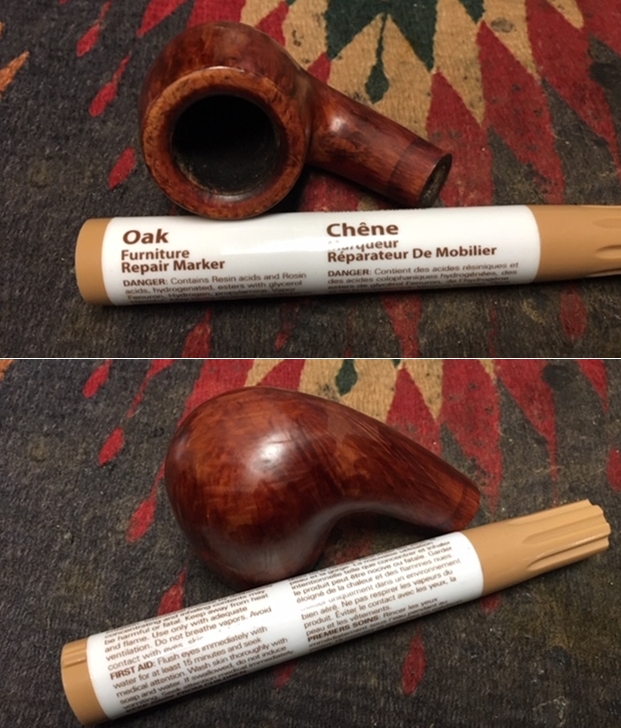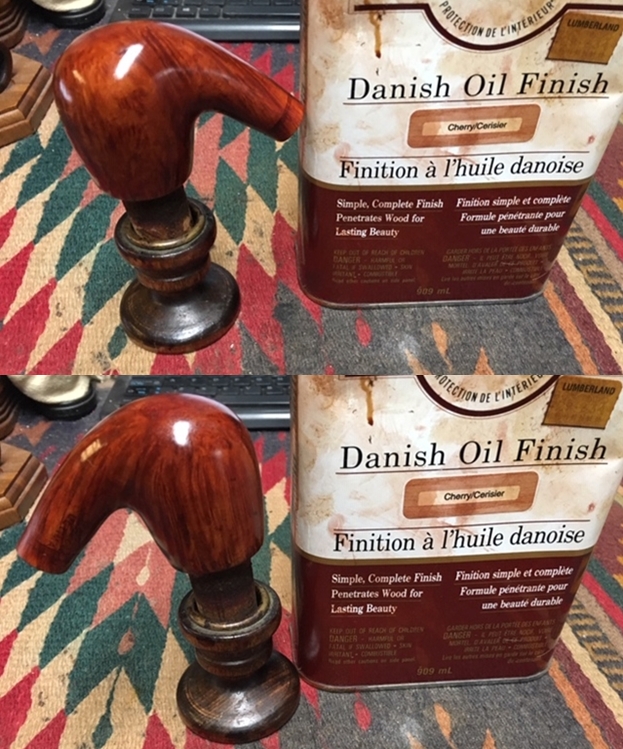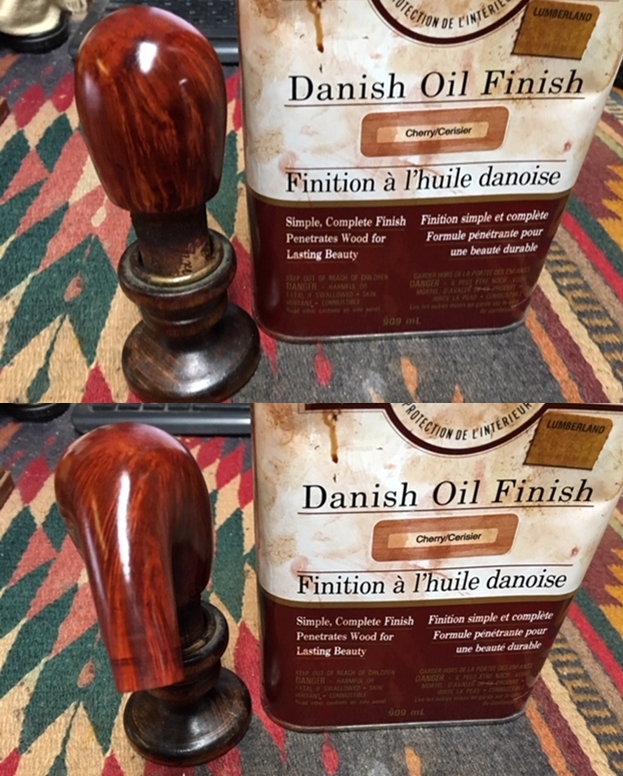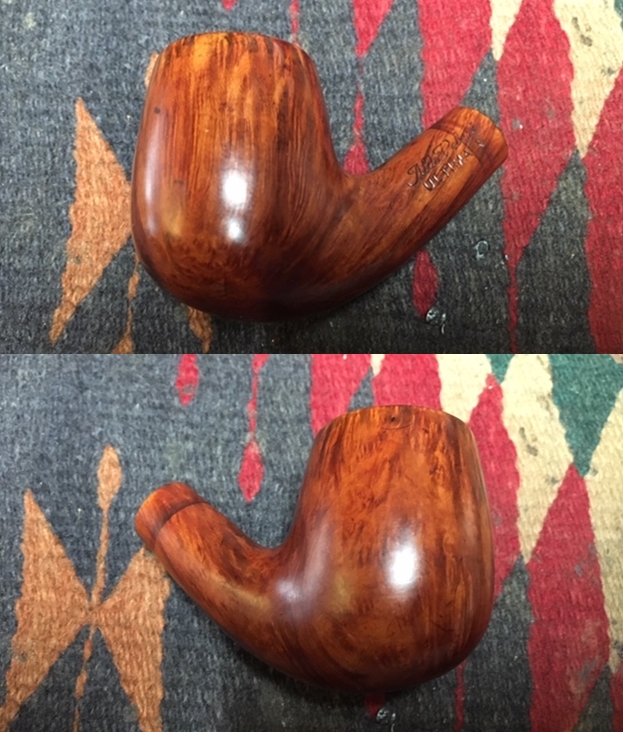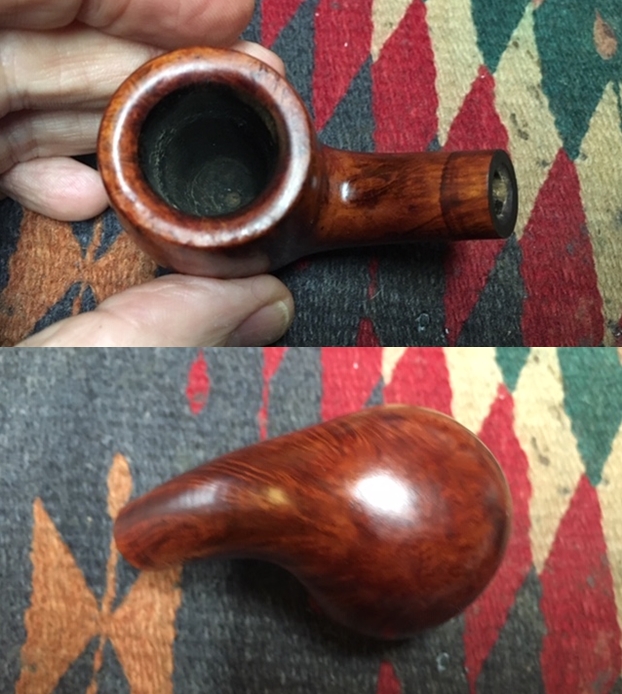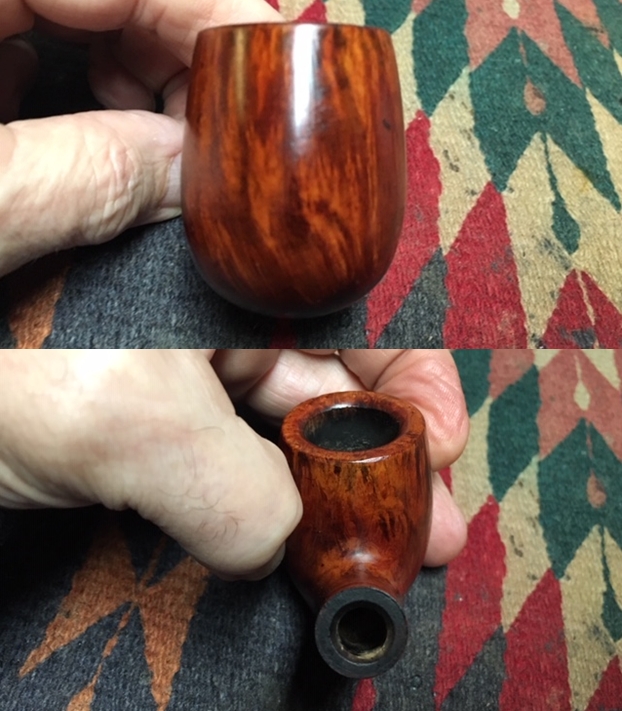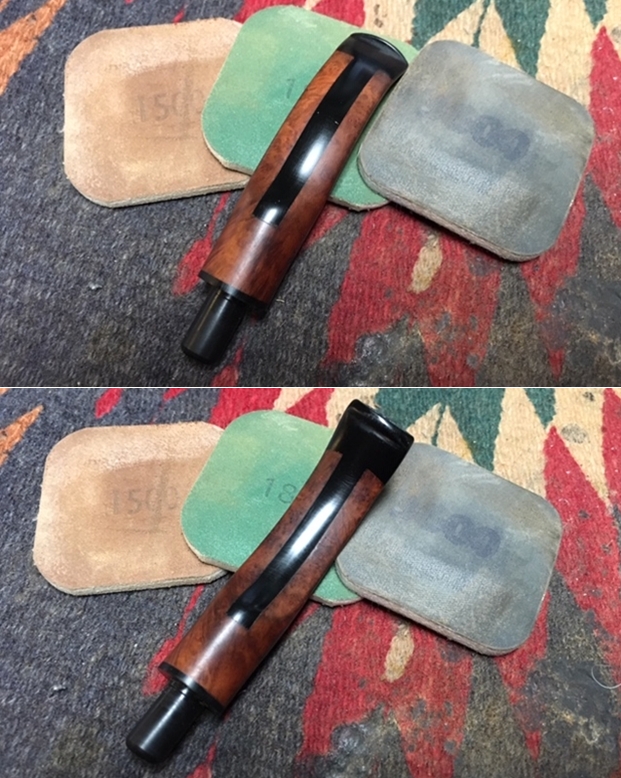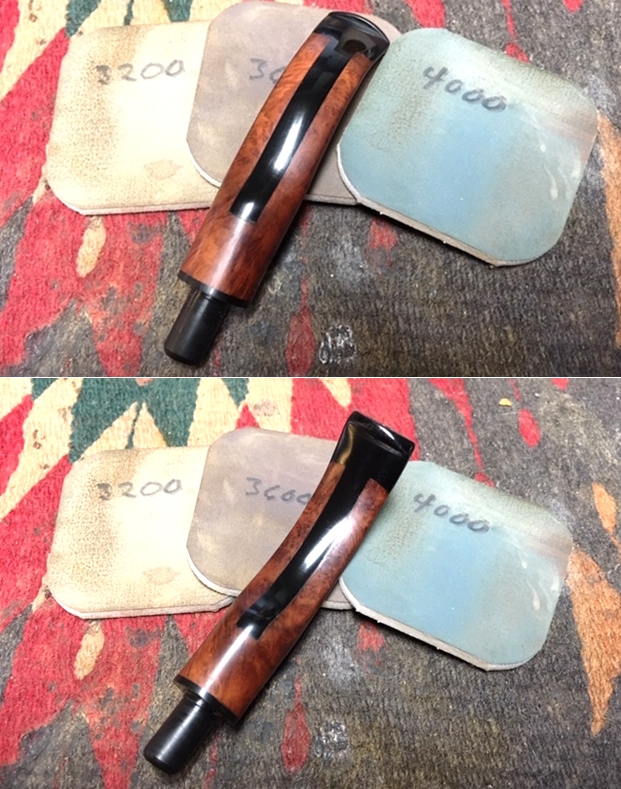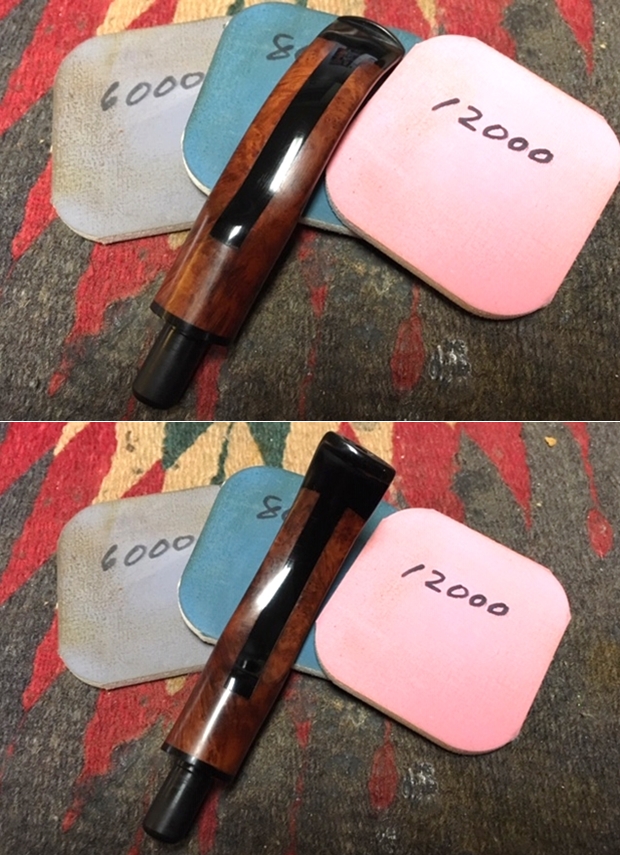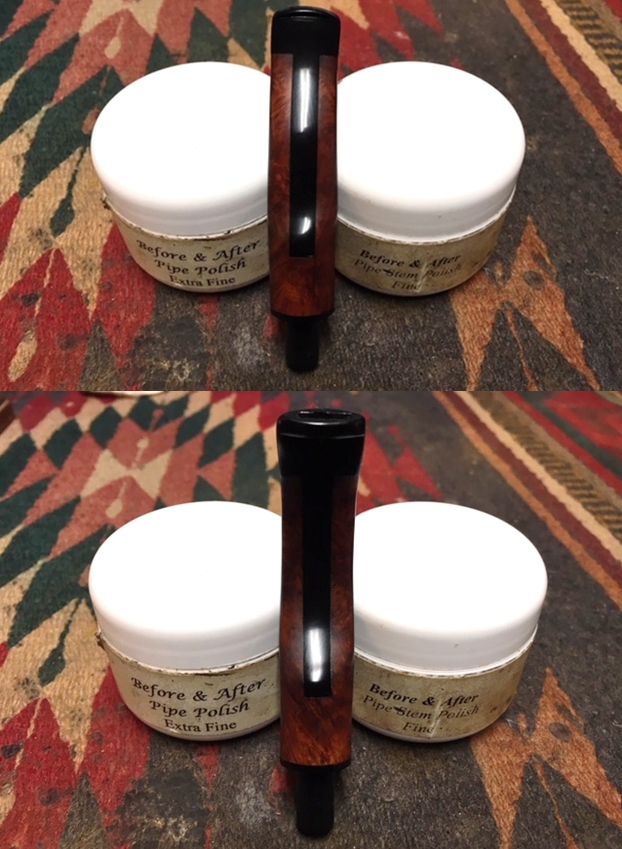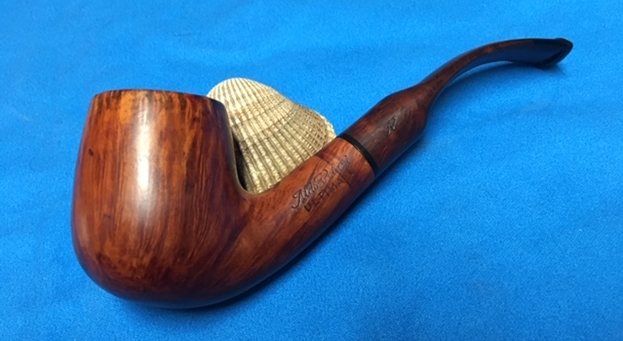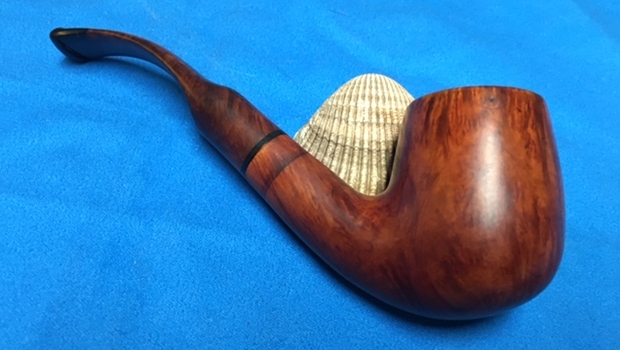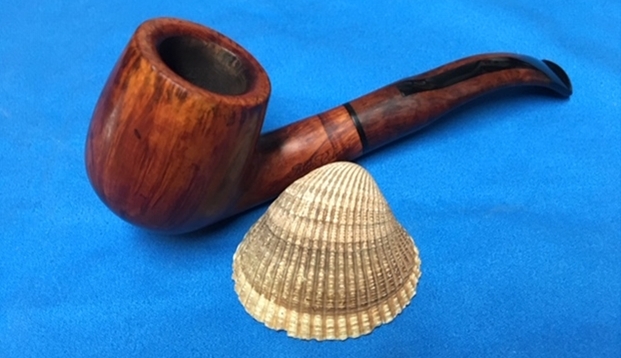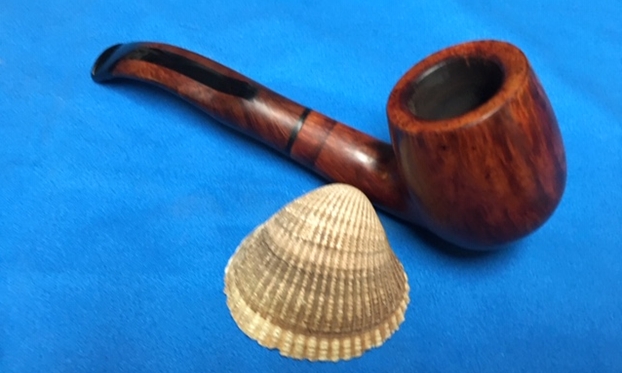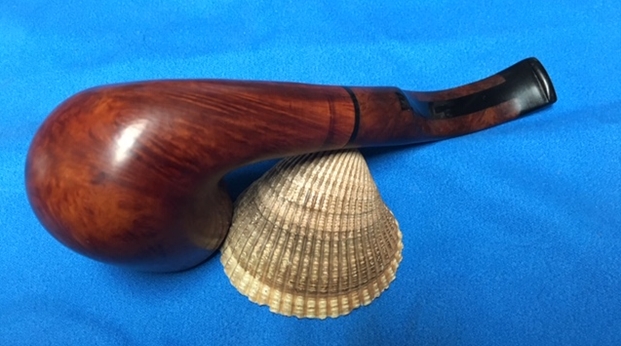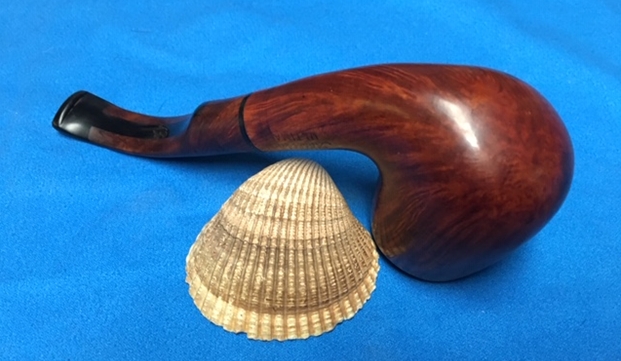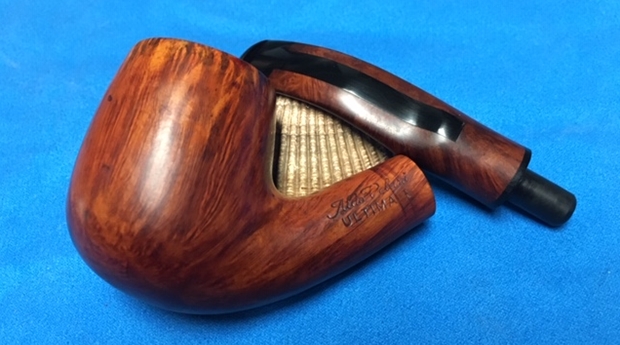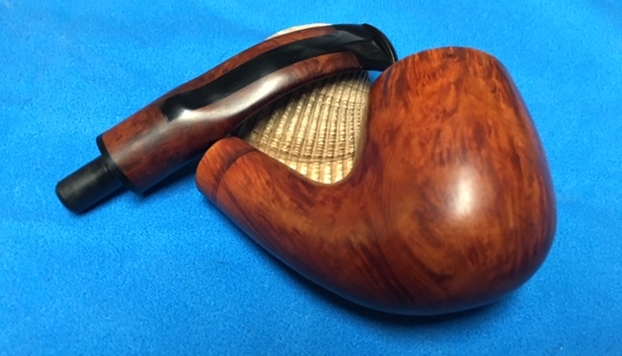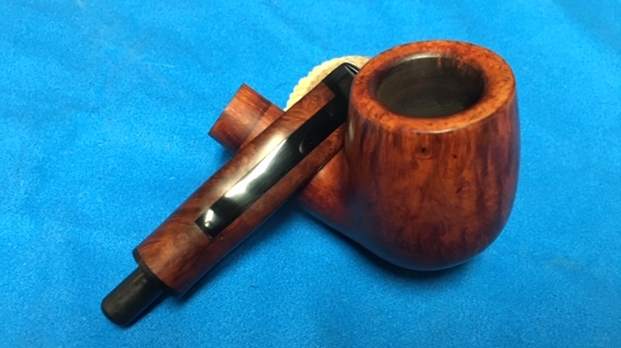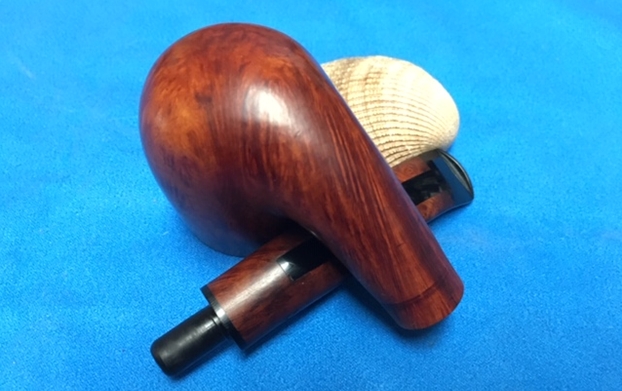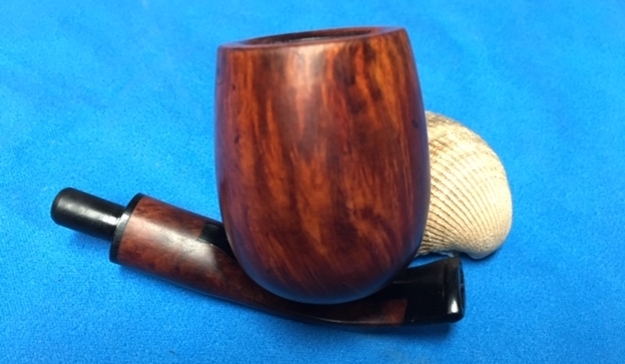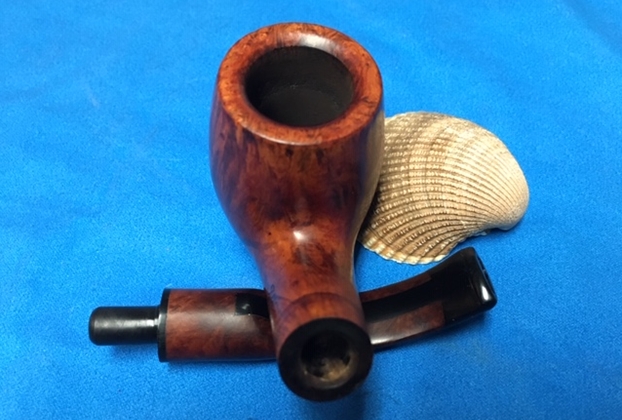Blog by Dal Stanton
The St. Louis Lot of 26 that my son, Josiah, found in an antique shop before last Christmas is where I landed the Aldo Velani now before me. He was impressed by the quality of pipes in the Lot and emailed me in Bulgaria with a proposition of going in together for the Lot of 26. His business proposal would be that his part would be his Christmas present to me – I would choose a pipe for my own from the Lot. My part of the purchase would be to acquire this Lot and posting them in my online collection, For “Pipe Dreamers” Only! for pipe men and women to commission to add to their collections benefiting the Daughters of Bulgaria. It was a proposal hard to refuse and some weeks later I unwrapped the St. Louis Lot of 26 in Denver where our family had gathered for Christmas. I chose as my gift from Josiah an unbelievable find in the picture below, a huge Champion Churchwarden. The Aldo Velani Trio Bent Apple is situated on the right just under the Churchwarden stem. Pipe man Michael saw the Aldo Velani in the Dreamers collection. Originally in the Lot, there were 4 pipes in the Aldo Velani Trio set. A Rusticated Volcano already found a home with a new steward (See: Rebuilding a Rim and Chamber for an Aldo Velani Trio Rusticated Volcano). The common characteristics of the set is the bright burgundy/reddish hue, the double-bumped gold banding and an assortment of acrylic stems. The set is attractive.
Pipe man Michael saw the Aldo Velani in the Dreamers collection. Originally in the Lot, there were 4 pipes in the Aldo Velani Trio set. A Rusticated Volcano already found a home with a new steward (See: Rebuilding a Rim and Chamber for an Aldo Velani Trio Rusticated Volcano). The common characteristics of the set is the bright burgundy/reddish hue, the double-bumped gold banding and an assortment of acrylic stems. The set is attractive. Michael was drawn to the Bent Apple and after communicating back and forth, he decided to commission it. Here are more pictures taking a closer look at the Aldo Velani Bent Apple. This line is a ‘bling’ line of pipes. The fancy acrylic stems with the double-bumped gold-plated ring, and the shine of the finish – all together give a bling, after dinner pipe feel. The Apple has an elegant presentation.
Michael was drawn to the Bent Apple and after communicating back and forth, he decided to commission it. Here are more pictures taking a closer look at the Aldo Velani Bent Apple. This line is a ‘bling’ line of pipes. The fancy acrylic stems with the double-bumped gold-plated ring, and the shine of the finish – all together give a bling, after dinner pipe feel. The Apple has an elegant presentation.  The chamber shows moderate buildup of cake and some lava flow over the rim.
The chamber shows moderate buildup of cake and some lava flow over the rim.  The clear acrylic stem has a burgundy airway that through the stem some build up is detected. I’m assuming that it’s burgundy colored and that its not supposed to be clear as well! We’ll see. Whenever I see a clear acrylic stem, the question is whether it’s a Perspex acrylic, an earlier more temperamental material that will not tolerate cleaning with alcohol and may craze or even shatter. I don’t think I need to worry about this because Perspex would be on older GBD pipes and early acrylic.
The clear acrylic stem has a burgundy airway that through the stem some build up is detected. I’m assuming that it’s burgundy colored and that its not supposed to be clear as well! We’ll see. Whenever I see a clear acrylic stem, the question is whether it’s a Perspex acrylic, an earlier more temperamental material that will not tolerate cleaning with alcohol and may craze or even shatter. I don’t think I need to worry about this because Perspex would be on older GBD pipes and early acrylic.  The bit is in great shape – almost no detectable tooth chatter.
The bit is in great shape – almost no detectable tooth chatter. The gold band I’m assuming is nickel plated as there are no markings showing a gold metal content. The double-bumped ring or shank facing is attractive and adds a touch of class as it joins the acrylic stem and Apple bowl. The ring will shine up nicely.
The gold band I’m assuming is nickel plated as there are no markings showing a gold metal content. The double-bumped ring or shank facing is attractive and adds a touch of class as it joins the acrylic stem and Apple bowl. The ring will shine up nicely. The nomenclature on the left shank side is cursive script, ‘Aldo Velani’ [over] ‘TRIO’.
The nomenclature on the left shank side is cursive script, ‘Aldo Velani’ [over] ‘TRIO’.  On the underside of the shank is the COM ‘ITALY’ and to the immediate right, the shape number ‘56’.
On the underside of the shank is the COM ‘ITALY’ and to the immediate right, the shape number ‘56’. The stem is stamped with a unique mark which I was able to figure out the last Aldo Velani I restored.
The stem is stamped with a unique mark which I was able to figure out the last Aldo Velani I restored. The Aldo Velani stem stamp is interesting and takes a closer look to figure out. I found in Pipedia’s Aldo Velani article, an example and details of the stamping on an original Aldo Velani box, courtesy of Doug Valitchka. The stamp depicts a pipe as the front leg of the ‘A’ for Aldo and the back leg of the ‘A’ forms the front riser of the ‘V’ of Velani.
The Aldo Velani stem stamp is interesting and takes a closer look to figure out. I found in Pipedia’s Aldo Velani article, an example and details of the stamping on an original Aldo Velani box, courtesy of Doug Valitchka. The stamp depicts a pipe as the front leg of the ‘A’ for Aldo and the back leg of the ‘A’ forms the front riser of the ‘V’ of Velani. From my earlier Aldo Velani post, the article cited from Pipedia provides helpful information understanding the provenance of the Aldo Velani name:
From my earlier Aldo Velani post, the article cited from Pipedia provides helpful information understanding the provenance of the Aldo Velani name:
Most Aldo Velani pipes are made in Livorno, Italy, for the USA market by Cesare Barontini. They were previously imported by Lane Limited. Lane spokesman Frank Blews once described Velani’s stylish, intrinsically Italian designs as “Billiards with more ball, bulldogs with more jaw.” The name “Aldo Velani” is actually fictional.
Another Barontini 2nd is named “Cesare”.
I learn two interesting things from this information. First, Aldo Velani is a faux name that does not describe an Italian pipe house but a specific pipe line. Secondly, the Aldo Velani line is made by the Casare Barontini name based in Livorno, Italy. Further information is available cross referencing to Casare Barontini in Pipedia:
In 1890 Turildo Barontini opened a factory for the production of briar. In 1925 his son Bruno began to produce the first pipes. Cesare Barontini, son of Bruno, started direction of the factory in 1955, and still runs it together with his daughters Barbara and Silvia.
Sub-brands & Seconds: Aldo Velani. Cesare, L’artigiana, Stuart, Cortina
Pipephil’s site has several examples of the Aldo Velani line depicted which tend to be very stylish and nice-looking pipes which confirms the Pipedia assertion that Casare Brontini produced the Aldo Velani lines primarily for export. It is evident that there was not a consistency in the stem stamping or name style for Aldo Velani as different examples are given. Here are the stem stamping variations provided by Pipephil: With a better understanding of the Aldo Velani Trio Bent Apple before me, I begin his refreshing by cleaning. I start by disassembling the parts – I find that the gold ring easily is removed which will allow cleaning of each element to be easier.
With a better understanding of the Aldo Velani Trio Bent Apple before me, I begin his refreshing by cleaning. I start by disassembling the parts – I find that the gold ring easily is removed which will allow cleaning of each element to be easier. I then take the stummel and ream the chamber using the Pipnet reaming kit. I use the 2 smaller blade heads then switch to the Savinelli Fitsall tool. Then sanding the chamber wall is done with 240 grade paper wrapped around a Sharpie Pen to further clean away the remaining vestiges of carbon. I wipe the chamber with a cotton pad wetted with isopropyl 95% and after inspection of the chamber, all appears to be healthy briar – I forgot to take a picture!
I then take the stummel and ream the chamber using the Pipnet reaming kit. I use the 2 smaller blade heads then switch to the Savinelli Fitsall tool. Then sanding the chamber wall is done with 240 grade paper wrapped around a Sharpie Pen to further clean away the remaining vestiges of carbon. I wipe the chamber with a cotton pad wetted with isopropyl 95% and after inspection of the chamber, all appears to be healthy briar – I forgot to take a picture!
 Next, to clean the external surface undiluted Murphy’s Oil soap is used with a cotton pad. The smooth surface is easily cleaned. Using a brass wire brush and a little help from my thumb’s fingernail the remaining lava is cleared.
Next, to clean the external surface undiluted Murphy’s Oil soap is used with a cotton pad. The smooth surface is easily cleaned. Using a brass wire brush and a little help from my thumb’s fingernail the remaining lava is cleared.
 The stummel is then transferred to the kitchen sink where the internal mortise is cleaned with shank brushes and anti-oil dish liquid soap. After scrubbing, the bowl is thoroughly rinsed and returned to the worktable.
The stummel is then transferred to the kitchen sink where the internal mortise is cleaned with shank brushes and anti-oil dish liquid soap. After scrubbing, the bowl is thoroughly rinsed and returned to the worktable.
 Continuing with the internal cleaning, I use two pipe cleaners and one cotton bud wetted with isopropyl 95% to discover that the internals are essentially clean. Nice for a change!
Continuing with the internal cleaning, I use two pipe cleaners and one cotton bud wetted with isopropyl 95% to discover that the internals are essentially clean. Nice for a change! Switching now to the acrylic stem, the shady areas inside the translucent airway I assume is build up which should be able to be cleaned.
Switching now to the acrylic stem, the shady areas inside the translucent airway I assume is build up which should be able to be cleaned.  I use a combination starting with isopropyl 95% and followed by a Soft-Scrub-like product I can find here in Bulgaria along with both bristled and soft pipe cleaners to clean the airway. With the bristled pipe cleaners, after wetting them with the CIT, I insert it into the stem and then ‘crank it’ to rotate in the airway. This does a good job.
I use a combination starting with isopropyl 95% and followed by a Soft-Scrub-like product I can find here in Bulgaria along with both bristled and soft pipe cleaners to clean the airway. With the bristled pipe cleaners, after wetting them with the CIT, I insert it into the stem and then ‘crank it’ to rotate in the airway. This does a good job. You can see that some of the burgundy color came off on the pipe cleaner as it cleaned. There is still some coloration in the airway, but it seems to be clean.
You can see that some of the burgundy color came off on the pipe cleaner as it cleaned. There is still some coloration in the airway, but it seems to be clean. After the cleaning of both the stummel and the stem, it is apparent that they are in good condition and for both I move directly to applying Blue Diamond compound, a mild abrasive, to both the acrylic stem and stummel. The compound will clear very small imperfections on both the stummel and acrylic surfaces. At this point, the gold-plated ring is kept off the shank for the application of compound. With a cotton cloth buffing wheel mounted to the Dremel and speed at about 40% full power, compound is applied to both stem and stummel.
After the cleaning of both the stummel and the stem, it is apparent that they are in good condition and for both I move directly to applying Blue Diamond compound, a mild abrasive, to both the acrylic stem and stummel. The compound will clear very small imperfections on both the stummel and acrylic surfaces. At this point, the gold-plated ring is kept off the shank for the application of compound. With a cotton cloth buffing wheel mounted to the Dremel and speed at about 40% full power, compound is applied to both stem and stummel. After the compound and after I wipe the pipe down with a felt cloth to clear the compound dust from the pipe, another cotton cloth buffing wheel is mounted with the same speed and carnauba wax is applied to only the stummel. The acrylic stem cannot be improved with wax! Following the application of wax, I use a microfiber cloth to give the pipe a vigorous hand buffing to raise the shine.
After the compound and after I wipe the pipe down with a felt cloth to clear the compound dust from the pipe, another cotton cloth buffing wheel is mounted with the same speed and carnauba wax is applied to only the stummel. The acrylic stem cannot be improved with wax! Following the application of wax, I use a microfiber cloth to give the pipe a vigorous hand buffing to raise the shine. A few more small projects are left. The ‘AV’ stamping on the acrylic needs refreshing. To match the gold ring, which is gold – the stamping in gold is a very nice touch.
A few more small projects are left. The ‘AV’ stamping on the acrylic needs refreshing. To match the gold ring, which is gold – the stamping in gold is a very nice touch. Using European Gold Rub’n Buff I apply a small amount of gold over the stamping. And as the name says, I rub and buff! The results are very nice.
Using European Gold Rub’n Buff I apply a small amount of gold over the stamping. And as the name says, I rub and buff! The results are very nice.
 Before reattaching the double-bump ring to the shank, I clean it using 000 steel wool.
Before reattaching the double-bump ring to the shank, I clean it using 000 steel wool. Then, placing a small amount of Extra Thick CA glue to the inside of the ring, I attach it to the shank. I use thick CA glue and only a small amount so that it doesn’t run over the confines of the ring.
Then, placing a small amount of Extra Thick CA glue to the inside of the ring, I attach it to the shank. I use thick CA glue and only a small amount so that it doesn’t run over the confines of the ring. With the ring reattached, the Aldo Velani Trio Bent Apple stummel and fancy acrylic stem are rejoined and enjoy another hand buffing with a microfiber cloth to raise the shine.
With the ring reattached, the Aldo Velani Trio Bent Apple stummel and fancy acrylic stem are rejoined and enjoy another hand buffing with a microfiber cloth to raise the shine.
Wow – what a party pipe! This pipe certainly has flare and bling and it’s the type of pipe that one wears matching cuff links! The Bent Apple shape provides a touch of elegance and the ensemble works well with the striking burgundy – reddish finish, the gold double-bumped ring and acrylic stem – with its matching airway running the length. Michael commissioned this Aldo Velani Trio Bent Apple and he will have the first opportunity to acquire it from The Pipe Steward Store benefiting the Daughters of Bulgaria. Thanks for joining me!











